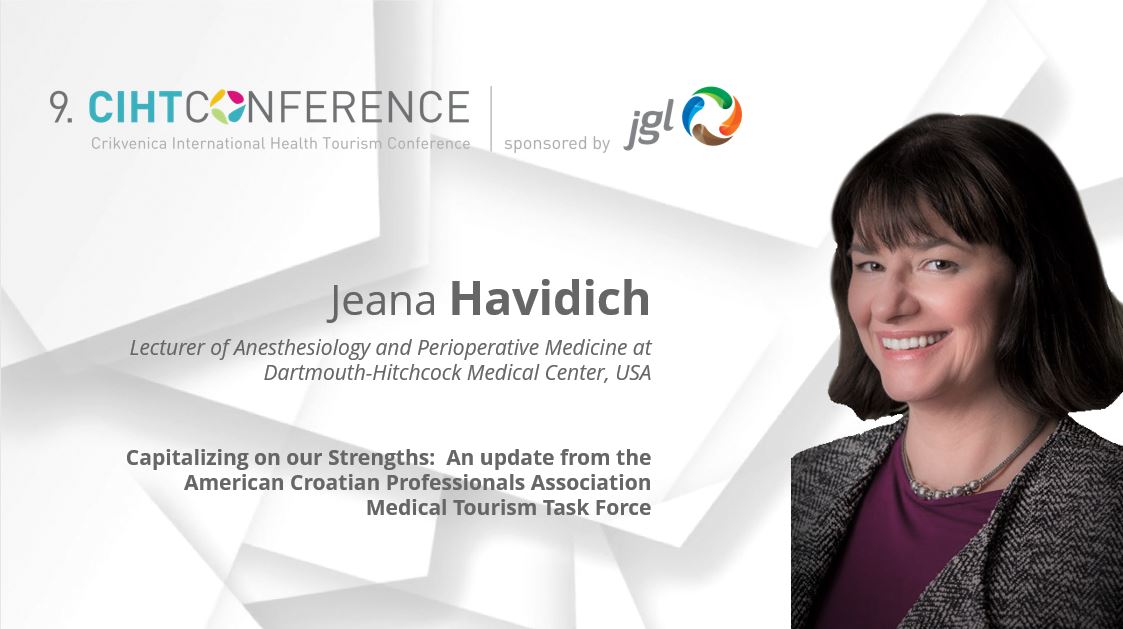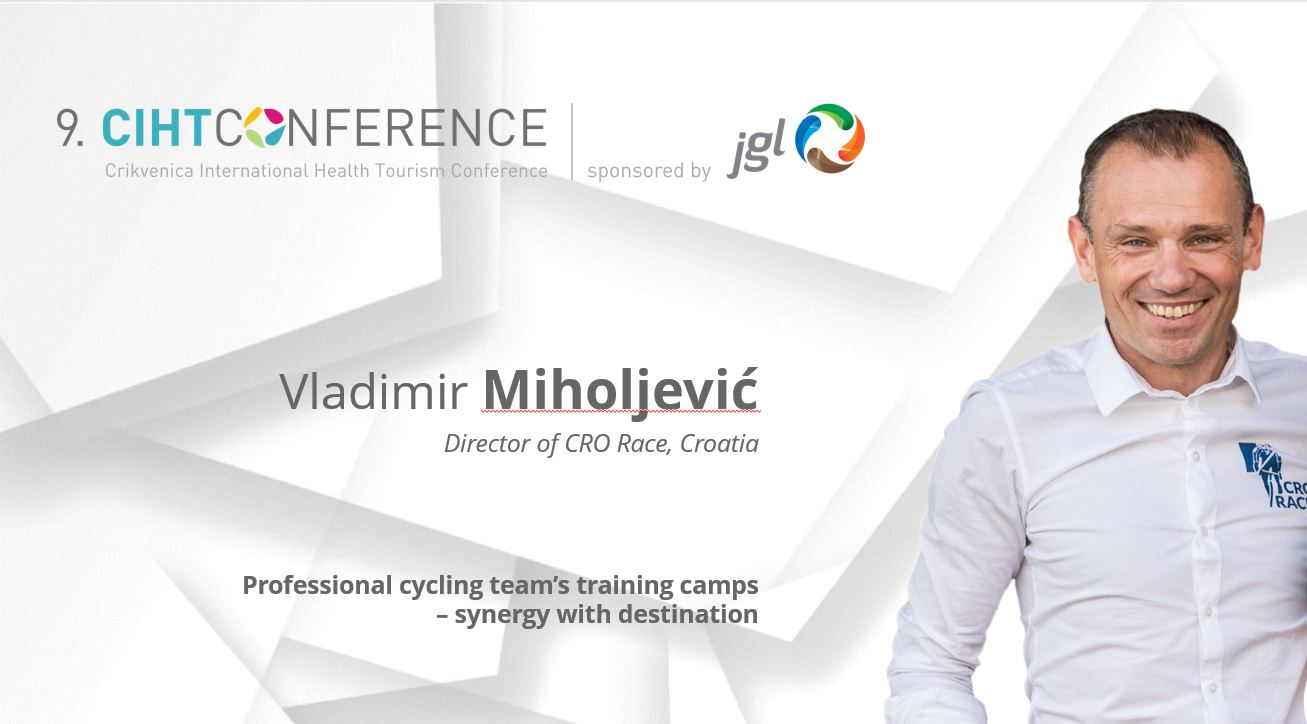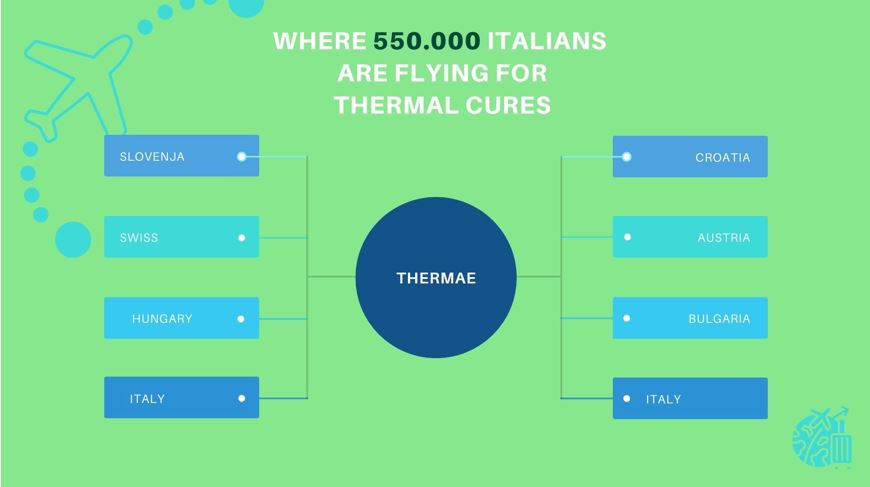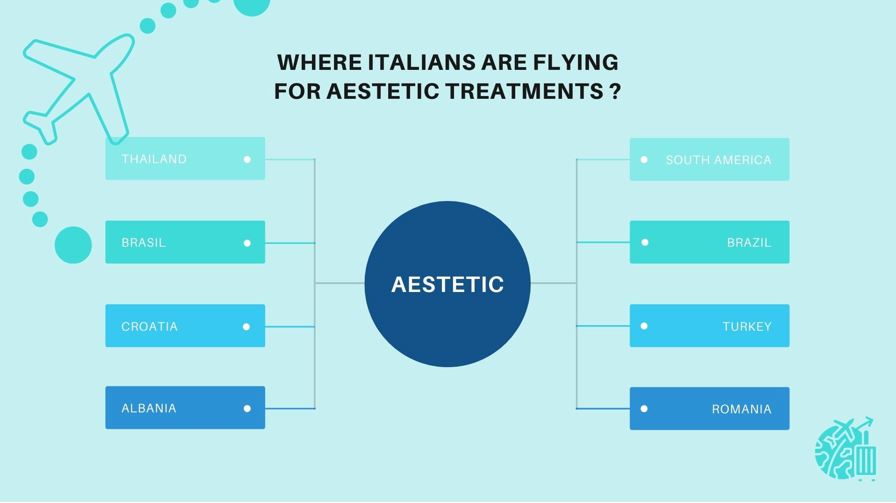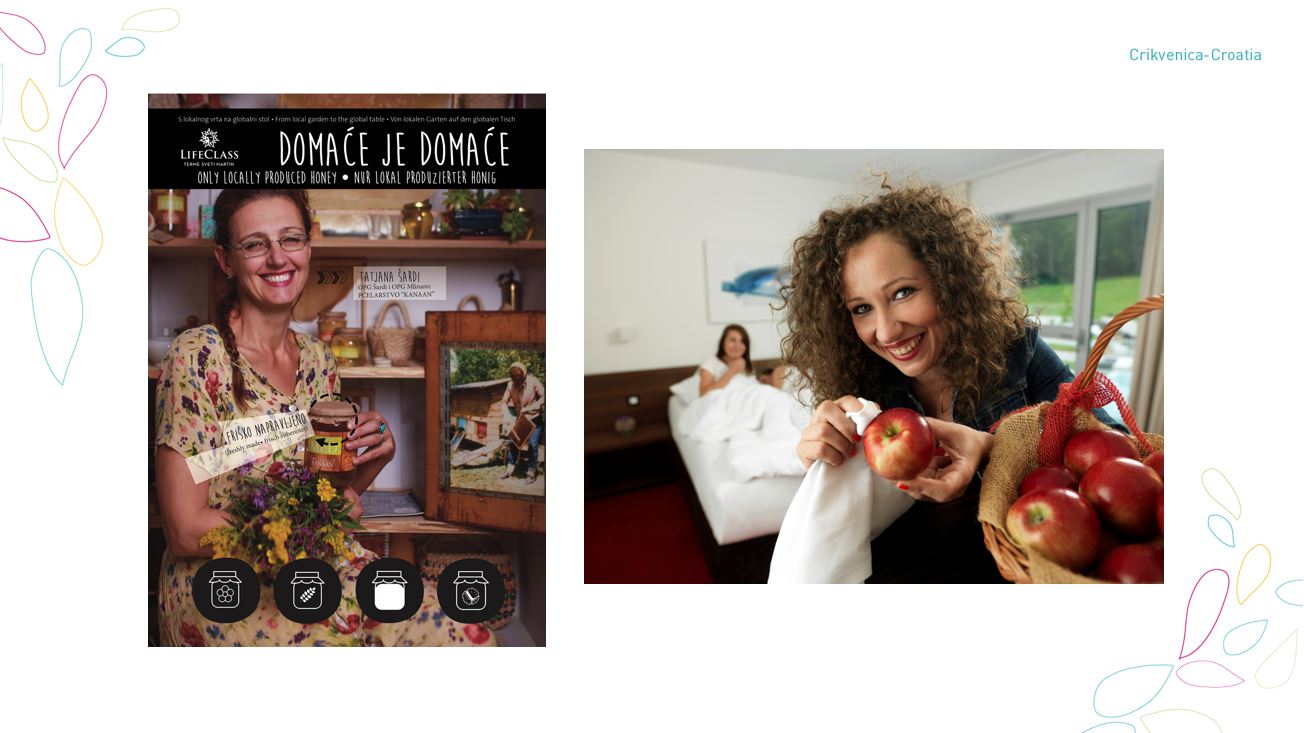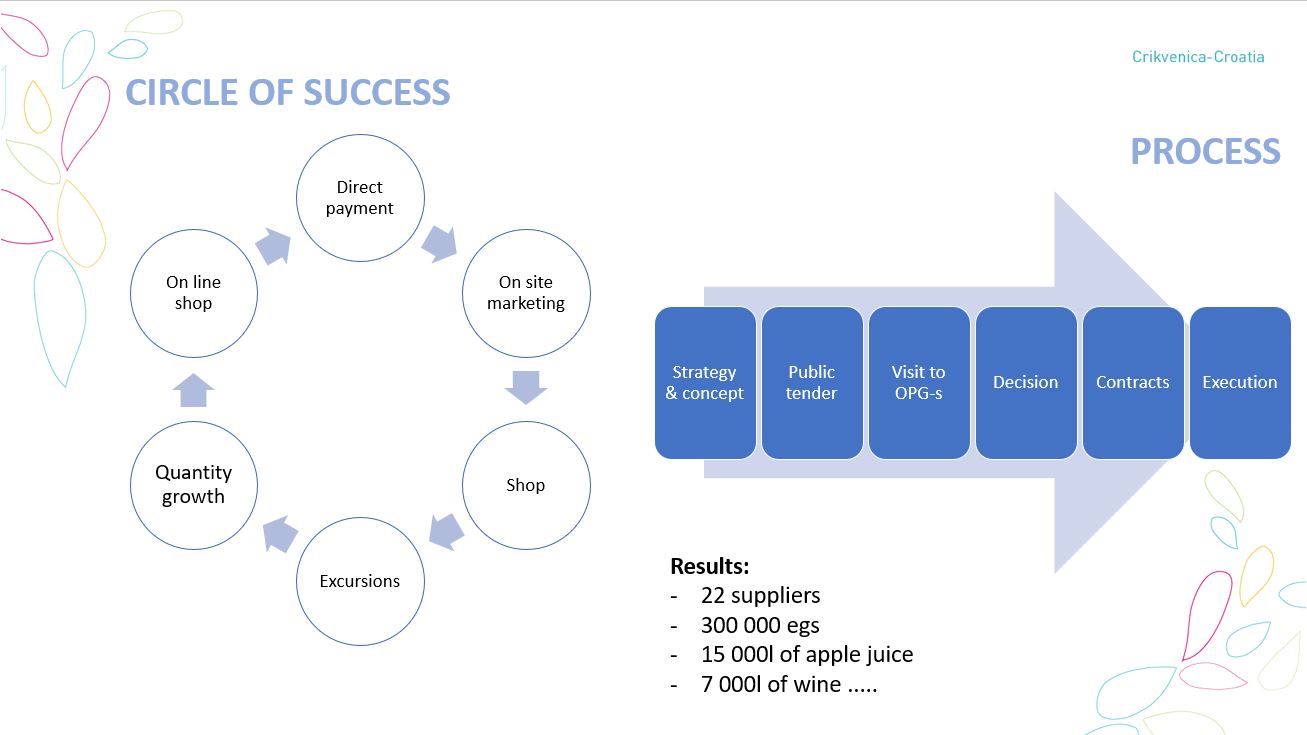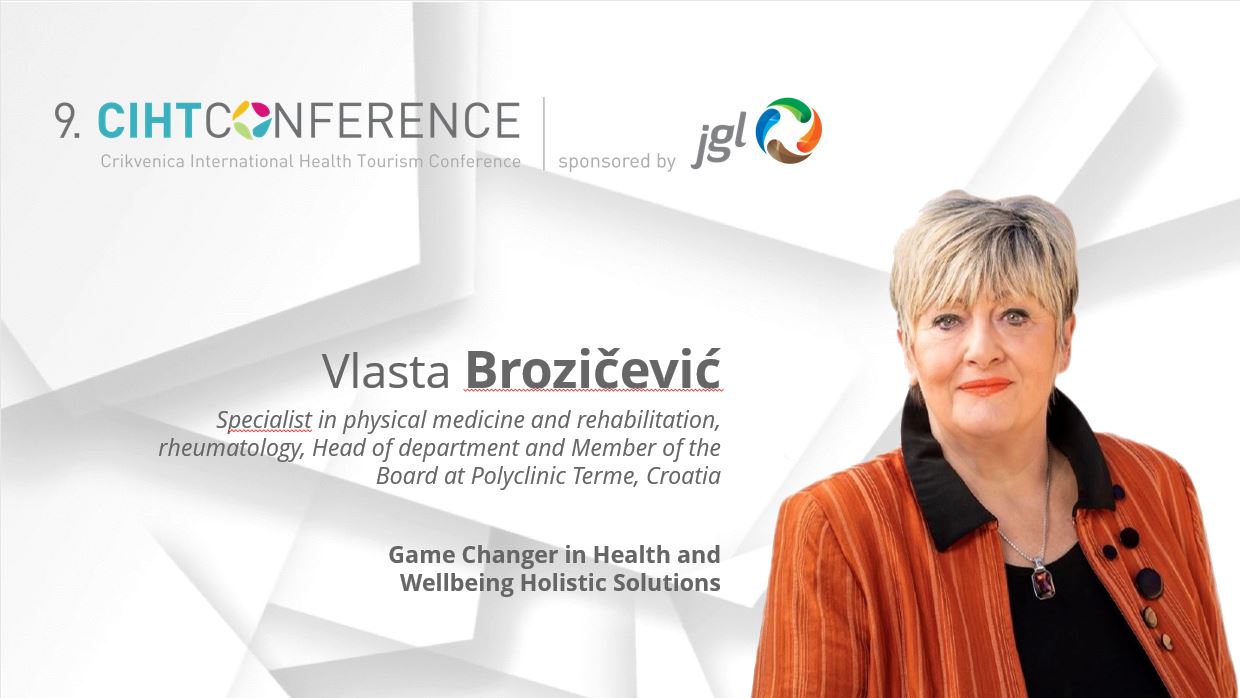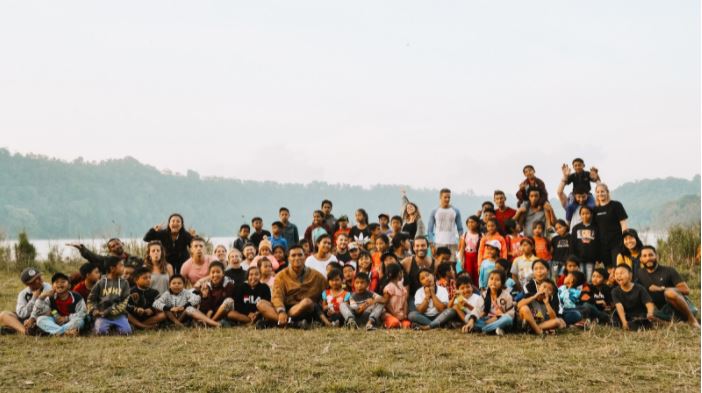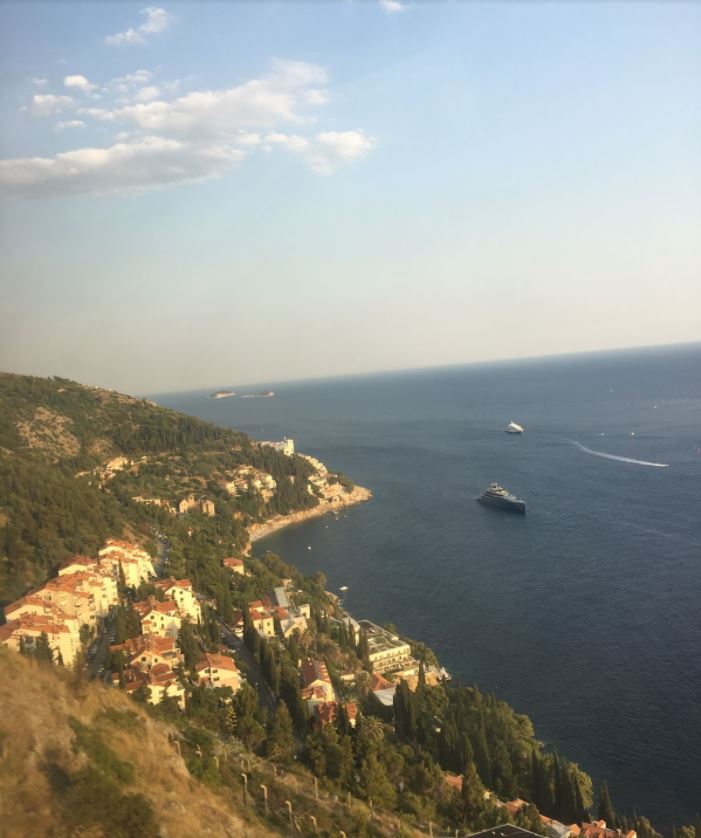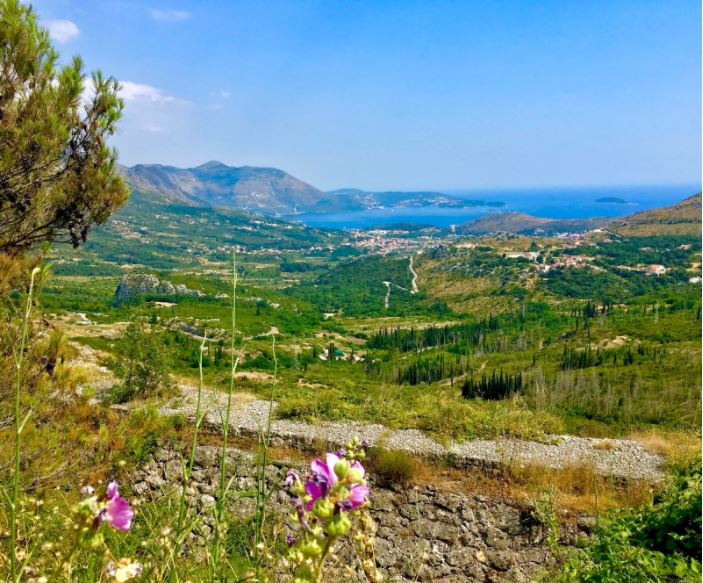Kvarner Full of Health Tourism Opportunity, as CIHT 2021 Shines
November 8, 2021 - Arguably the leading health tourism conference in the region exceeds expectations once again, and the opportunities are numerous for Kvarner Full of Health at CIHT 2021.
Full disclosure - I love everything about the Crikvenica International Health Tourism (CIHT) conference, and I rate it as the very best of all the (many) conferences I have attended in Croatia over the years.
Medical tourism is not a niche I would normally associate myself with. In fact, until the dynamo that is Ognjen Bagatin of the award-winning Bagatin Clinic introduced me to the sector a few years ago, I didn't even realise that Croatia had a quality medical tourism sector.
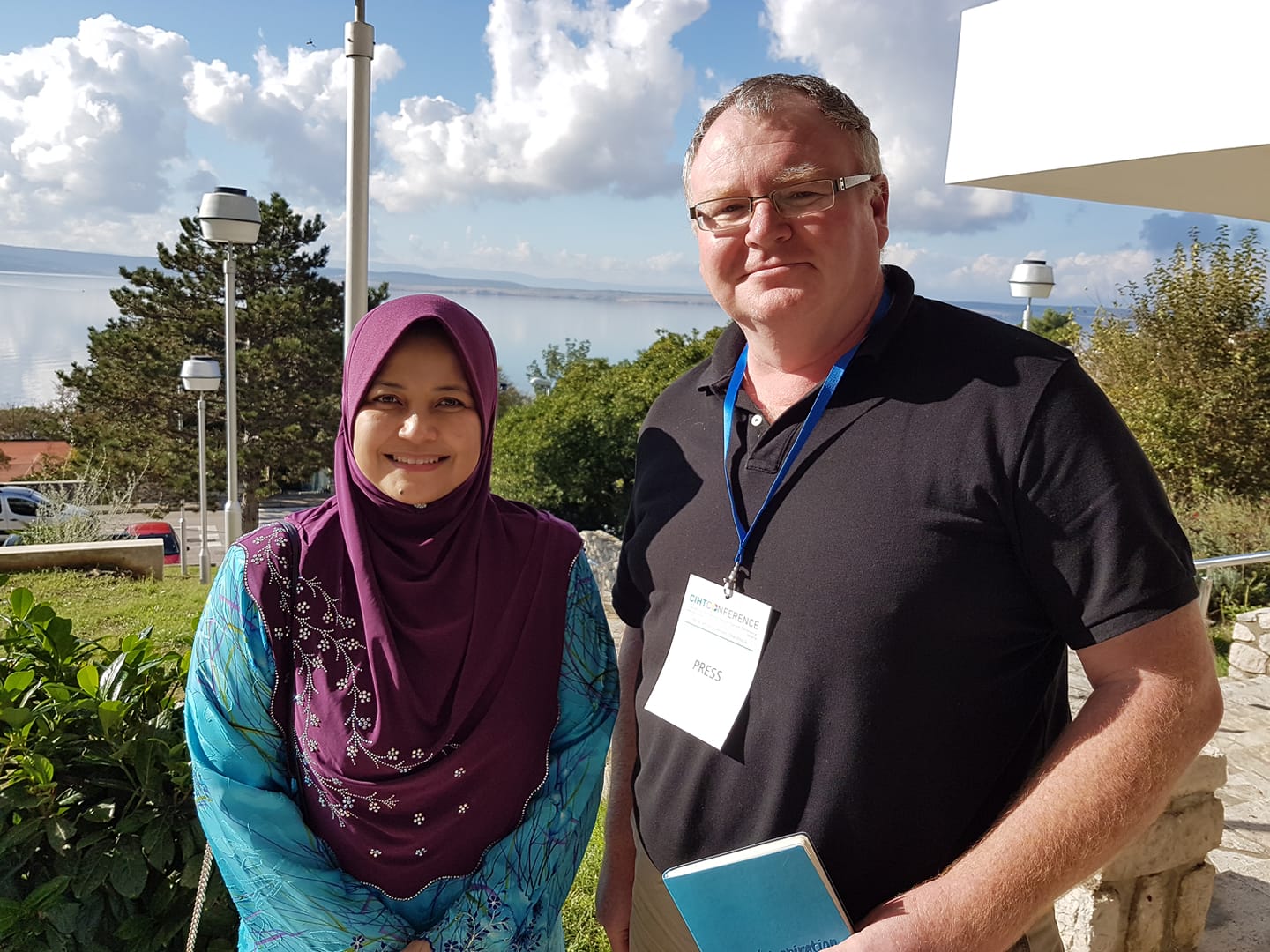
And then I went to CIHT 2018, met this lady, and life was never the same again.
There were tears of admiration and of envy from the largely Croatian health tourism sector audience as Sherene Azli, the charismatic CEO of the Malaysia Healthcare Travel Council, explained in detail how Malaysia had taken its medical tourism industry from nothing to about $2 billion dollars through a hugely successful public/private partnership and a hashtag that would never catch on in Croatia sadly - #TogetherWeWin. You can read Lessons from Malaysia in Croatia: MHTC CEO Sherene Azli on Health Tourism.
Nine months later, sporting a Varteks suit, I found myself in the rather surreal position of accepting an award in Kuala Lumpur at the inaugural Medical Travel Media Awards in August 2019.
The thing was, however, that Sherene was far from being the only world-class speaker on the stage in Crikvenica. At CIHT 2018, I also interviewed Keith Pollard, Editor of International Medical Travel Journal, as well as branding experr, Ilan Geva from the USA - Croatian Medical Tourism: Great Potential, Collaborate or Die Says Ilan Geva.
I had no idea that the topic of medical tourism could be so interesting, or full of so much (yes, the P word again in Croatian tourism) potential. I was hooked.
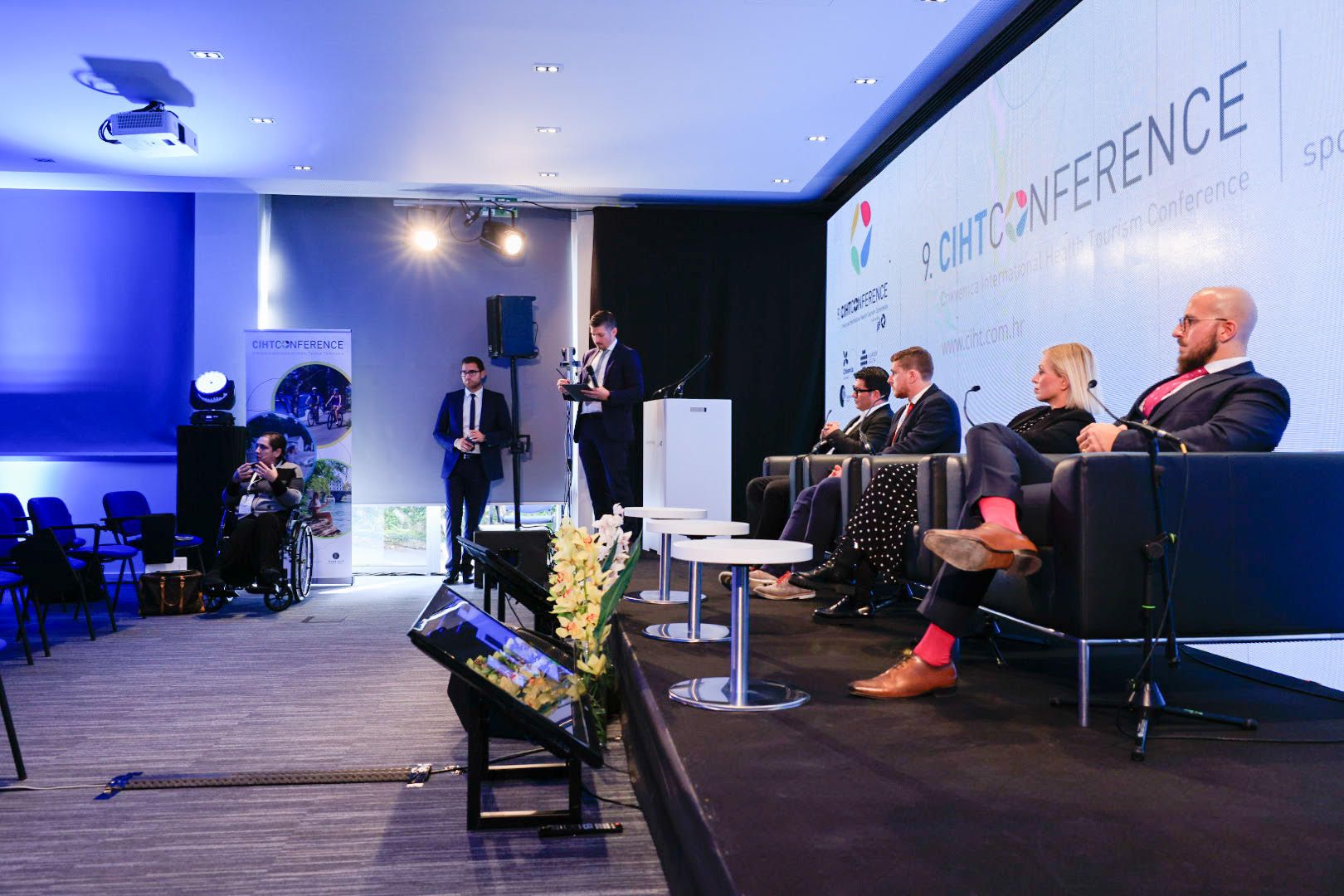
Over the years, CIHT has consistently thought out of the box, bringing different viewpoints, not all of which are focused 100% on health tourism. Global tourism expert Doug Lansky was the star of the show two years ago with Lessons for Croatia: Successful Tourism by Doug Lansky at CIHT 2019.
Added to the fact that CIHT is superbly run and has a great social aspect to it, and little wonder that it is the first conference I look out for. October 6-7, 2022 are already in my diary for CIHT 2022.
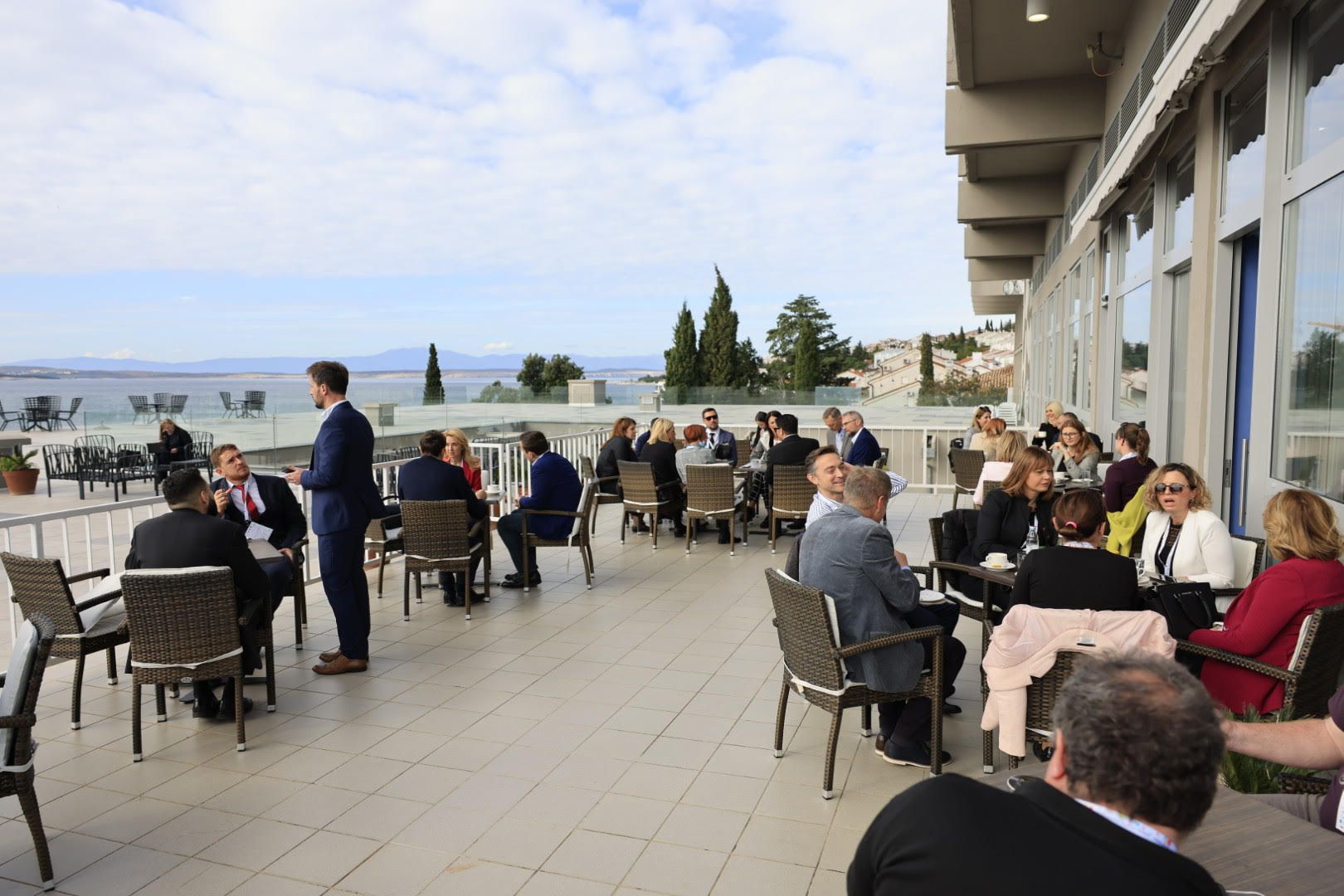
And this year's event brought so much brain food, and the timing of so of its presentations was timely indeed. I could go on for hours but here are some key points which tie in to developing Croatia's untapped opportunities.
One of the great initiatives in the medical tourism sector has been the Medical Tourism Task Force, as part of the American Croatian Professionals Association (ACAP). Cleveland has a very strong Croatian connection with medical tourism, most notably in the form of the CEO of Cleveland Clinic, Tomislav Mihaljevic. Ognjen Bagatin has done a phenomenal job over the years strengthening that relationship, and ACAP's Jeana Havidich flew in to address the conference to update the conference on progress being made to attract the target audience od 1.2 million Croatian diaspora.
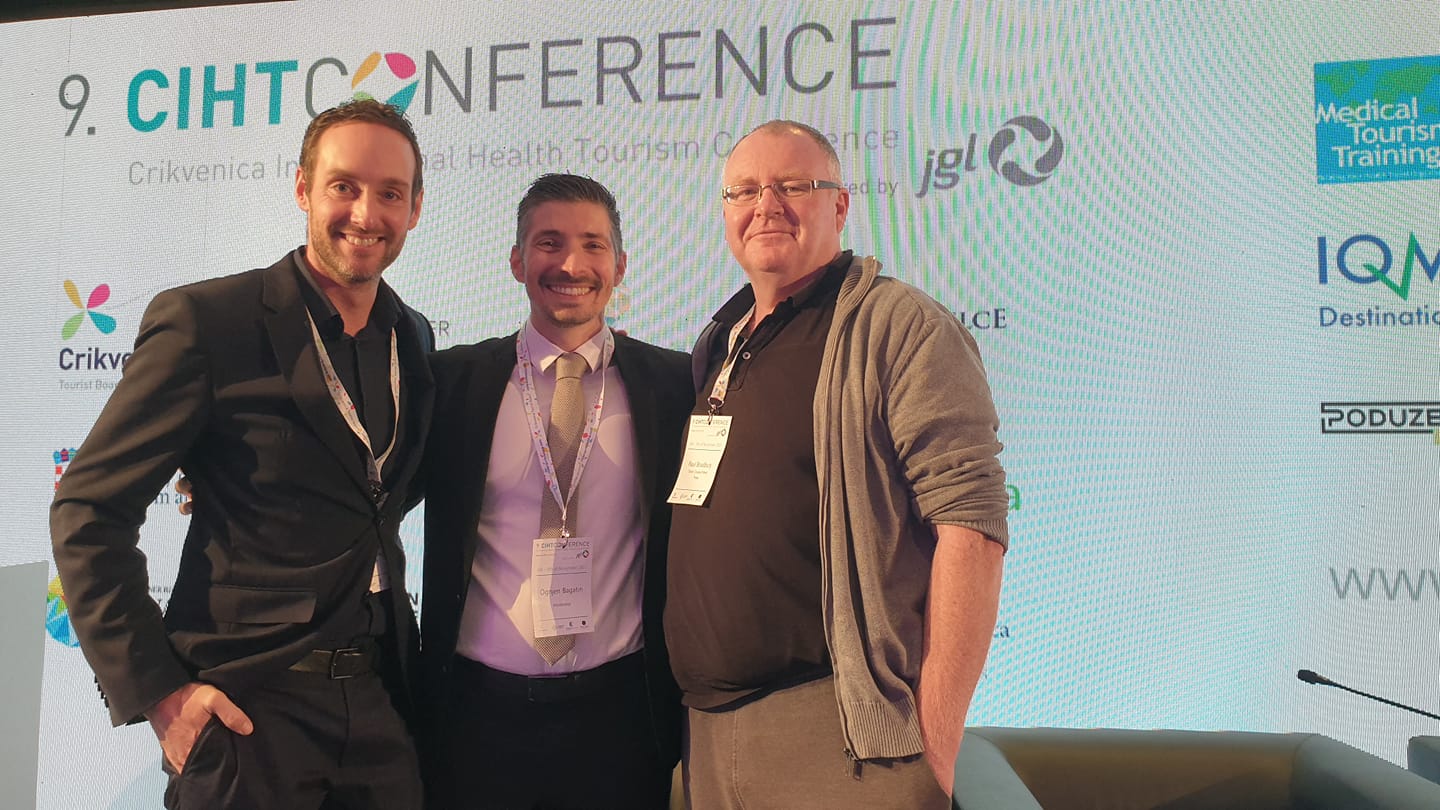
Jeana was followed by our favourite Dutch wannabe tomato-grower, Jan de Jong. Best-known for his successful push to bring a digital nomad visa to Croatia, Jan gave a great presentation on Croatia, the Land of Opportunity and his version of Living the Croatian Dream. Jan has really developed as a public speaker since I first heard him at Business Cafe International in Zagreb a couple of years ago. And his positivity is infectious, and it is slowly dripfeeding into the Croatian mindset of many local people.
And then I made my first big connection of the day - a wonderful opportunity.
Until now, the focus has been on trying to attract foreign patients to come to Croatia for treatment. But now there is another opportunity, far bigger than the 1.2 million diaspora in the USA - the remote worker.
Due to the efforts of Jan and many others, Croatia is starting to attract a significant number of digital nomads and remote workers. We are at the tip of the iceberg and the beginning of a journey, and this - at least in my opinion - is the biggest opportunity Croatia has to develop its tourism sustainably.
The big difference between the diaspora and remote worker in terms of targeting is that the remote worker is already coming here for an extended period. They are choosing Croatia for the lifestyle, excellent WiFi, safety, nature, authentic experiences, food and drink, accessibility and affordability. The majority do not even know that Croatia has a world-class medical tourism industry. Imagine if they were educated on the potential (an overview here) - one more great reason to choose Croatia for the next office.
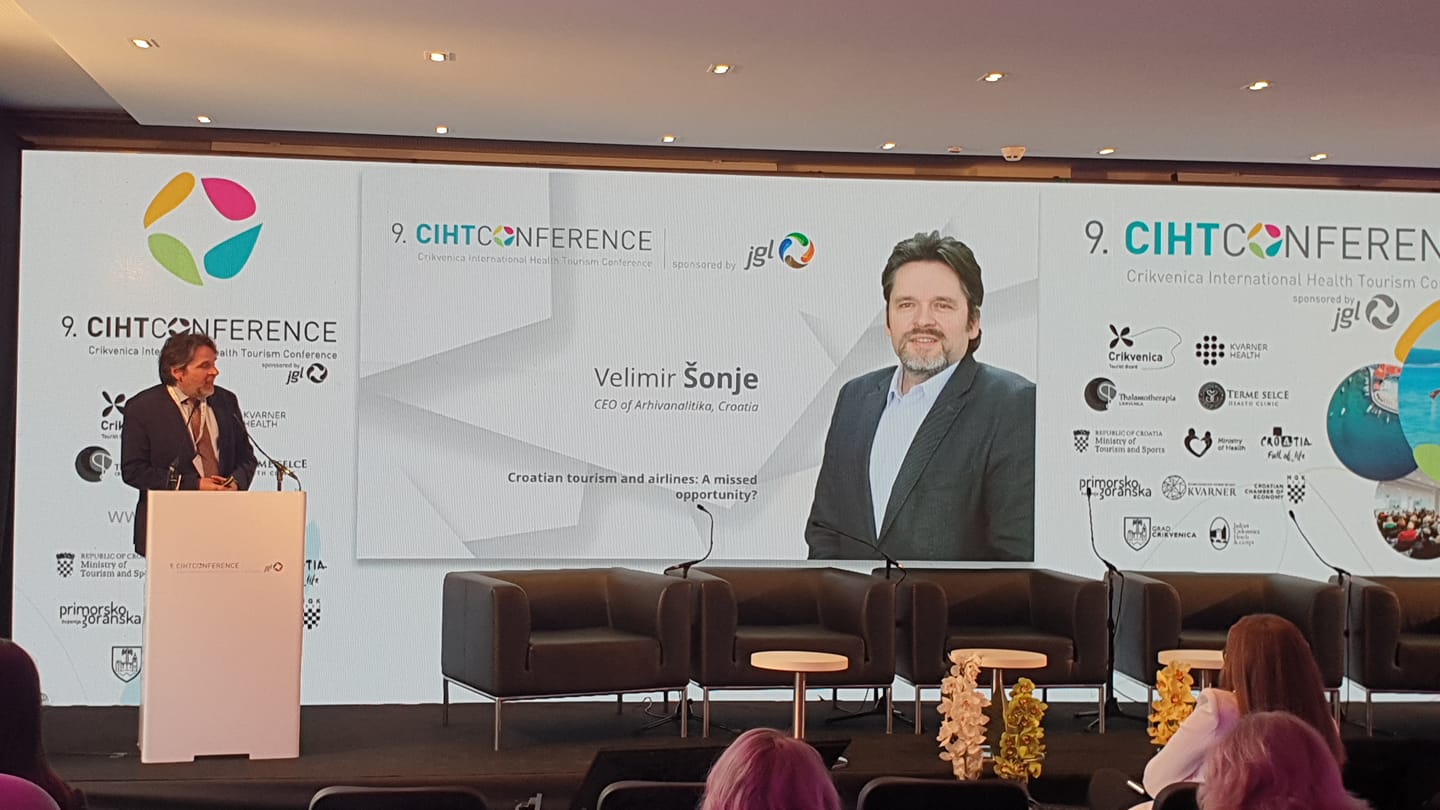
I was beginning to think that CIHT organisers Alfred and Vladimir were organising presentations just for me. One of the initiatives I am involved with is to restart winter tourism on the Croatian coast. Did you know, for example, about the following number of international routes connected with winter flights: Dubrovnik (2), Split (6 - 2 different countries), Banja Luka (14 - 8 countries), Nis, Serbia (12 - 7 countries), Thessaloniki (80 - 23 countries), Bari (76 - 18 countries), Alicante (167 - 24 countries), Venice (75 - 26 countries). Read more in Wow! Comparing Split, Dubrovnik Winter Flights to ExYu, Mediterranean Competition.
Velimir Sonje, CEO of Croatian startup ETF Airways (which flies all over Europe but not in Croatia) gave a great presentation on Croatian Tourism and Airlines: a Missed Opportunity. Lots of thought-provoking stuff that I will be exploring in greater detail with Velimir over a beer in Zagreb soon.
Next up was another hero of mine, achieving incredible things and promoting both Croatia and its healthy lifestyle internationally. Vladomir Miholjevic has done so much to put Croatia on the global cycling map, from bringing his Bahrain Merida (as it was then) to Hvar for winter training for several years, to organising the fabulous CRO Race, an event that was beamed all over the globe.
And then I realised what it is that I love about CIHT - it is a place where Croatian world-class excellence is celebrated by real people who are doing not talking.
And connecting, to make a better eco-system for all.
And then came the presentation that blew my mind, as Maria Antonietta Princivalle from BookingsMed gave a fascinating overview of the outbound Italian medical tourism market. According to Maria, Croatia has an excellent medical tourism reputation in Italy, both in terms of price and quality. And the Italian market brings significant revenue to the clinics of Istria and Kvarner.
But how much of an opportunity is Croatia missing out on with this captive market - great reputation, proximity, no language barrier?
Some 550,000 Italian patients go abroad each year for thermal cures, some driving as far as Prague.
Some 350,000 cross the border each year for aesthetic treatment, as far away as Thailand and Brazil.
Back to Croatian excellence. Next up, Branimir Blajic, who gave a fascinating presentation of the case study of Sveti Martin in promoting local producers and their local products.
This is SUCH an obvious one for Croatia to develop, with its rich network of small producers of high-quality produce. Blajic showed how it could be done, and TCN will soon be reporting from Medjimurje on this excellent initiative, as well as exploring how we can expand its scope.
And no CIHT conference would be complete without the visionary legendica, Vlasta Brozicevic of Teme Selce, who gave an inspiring presentation entitled Game Changer in Health and Wellbeing Holistic Solutions.
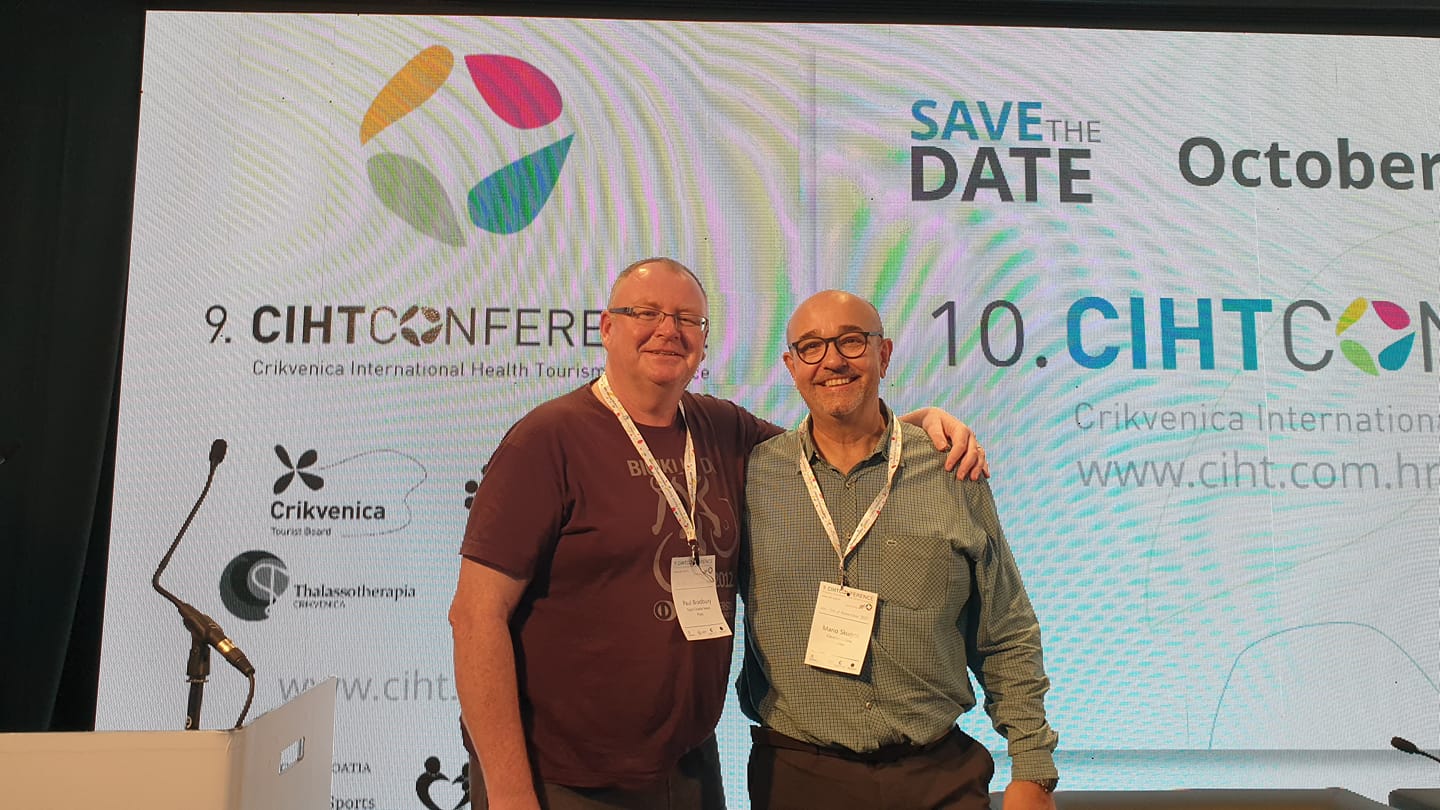
It is a sign of the growing relevance and excellence of CIHT that medical tourism professionals of the quality of Mario Skugor, of Cleveland Clinic, flew in for the conference. It was great to see full two-day attendance from the Zagreb Tourist Board and the medical tourism department of the Ministry of Tourism, as well as the Ministry of Health. It was, however, a little disappointing (although not surprising) that the Kingdom of Accidental Tourism, aka the Croatian National Tourist Board, could not make the 2-hour journey from Zagreb when others had made such an effort, only joining remotely.
An outstanding two days, with great networking and new opportunities. There seems to be a renewed momentum within the Croatian medical tourism industry. And as one can see from the above, the opportunities are plentiful.
CIHT 2022 will take place on October 6-7, 2022 - it promises to be quite a 10-year party.
To learn more about the Kvarner Health Tourism Cluster and its excellent work, visit the official website.
Read more - 'The Healing Garden of Europe': Kvarner Health Cluster's Vladimir Mozetic Interview.
Russian Vaccination Tourism in Zagreb: 6-Weekly Flights Announced from Moscow!
November 8, 2021 - Russian vaccination tourism in Zagreb is the latest trend, as Russian citizens flock to the Croatian capital to get jabbed with an EU-approved vaccine. Recall, Sputnik, the Russian vaccine, has yet to be accepted by the European Union - and EU digital Covid certificates are a hot commodity.
As TCN reported on Sunday, November 7, Russian citizens waited in line for hours at the small vaccination point in Zagreb's Kajzerica neighborhood last week, hoping they could get vaccinated. It's not that Russians are having trouble getting vaccinated in their country, but only the Sputnik vaccine is available, which has yet to be approved by the European Union.
Thus, increased demand and high capacity on flights to Zagreb from Moscow this offseason are primarily thanks to the coronavirus vaccine. Many hope to get jabbed with Johnson & Johnson since only one dose is needed, after which they can receive an EU digital Covid passport to travel freely and avoid self-isolation or quarantine.
Four Russian airlines, Aeroflot, PegasFly, Nordwind, and Azur Air, are currently operating on scheduled flights between Moscow and Zagreb. However, Azur Air was the last to introduce a route at the end of October this year, reports Croatian Aviation and 24 Sata.
Russia's national airline, Aeroflot, operates between Zagreb and Moscow three times a week, every Monday, Wednesday, and Friday. Although the announcement included A320 aircraft with a capacity of 158 seats, due to increased demand, larger A321 aircraft with 183 seats mainly operate on this line.
The planes are recording excellent occupancy, and there are only a few vacancies left on the flights in the following days. The question is whether Aeroflot will further increase its capacity to Zagreb by introducing wide-body aircraft. If there is no further increase, Aeroflot will offer almost 3,500 seats between Moscow and Zagreb by the end of the month.
Nordwind and PegasFly also operate between Moscow and Zagreb, twice a week - Nordwind on Mondays and PegasFly on Fridays. By the end of November, the two airlines offer 2,172 seats between Moscow and Zagreb. Flights are operated with E190 and B737-800 aircraft.
The newest carrier between Moscow and Zagreb is Azur Air, which operates to Zagreb from Vnukovo Airport, while other airlines use Sheremetyevo Airport. Azur Air operates to the Croatian capital only once a week, on Sundays, using aircraft type B737-800. By the end of November, this carrier will offer 1,512 seats between Moscow and Zagreb, and the company claims that if there is increased demand, it will react by introducing a B757-200 aircraft with a capacity of 238 seats.
By the end of November, the four mentioned airlines would offer a total of 7,164 seats between Moscow and Zagreb, and flights are available six times a week.
For more on flights to Croatia and other travel announcements, make sure to check out our dedicated travel section.
Wow! Comparing Split, Dubrovnik Winter Flights to ExYu, Mediterranean Competition
November 8, 2021 - How do Split and Dubrovnik winter flights compare to other cities in the region, as well as competitor destinations on the Mediterranean. Quite interesting...
I am just back from a couple of trips to the Adiatic coast in October and November.
So much beauty, such a great time to visit.
And yet...
Split and Dubrovnik winter flights are as scarce as summer flights are abundant, and the whole Dalmatian coast largely goes to sleep from the end of October until March.
It was not always that way, as we learned in a recent TCN interview with a UK tour rep in the 1980s, who explaine how year-round flights were bringing in Americans for stays of up to 6 weeks. Read more in Croatian Winter Tourism in 1990: Full of Life! Tour Rep Interview.

And yet, there are pockets of the coast which are very much alive in the winter months. Small initiatives that show there are people here - and the feeling that many more would come if the likes of Split and Dubrovnik were more accessible. Above is a photo from Nomad Table in Split on Friday night, a weekly event hosted by Saltwater Nomads and Zinfandel in Split. It was packed and sold out - again. I spoke to several remote workers who are enjoying Split as their temporary new home. More flights and easier access, combined with a proper strategy would increase their numbers considerably.
After writing a few articles on the potential of winter tourism recently, I asked if there was anyone with something to contribute on the subject who would be interested in getting in touch to kickstart an initiative to improve the Split and Dubrovnik winter flights situation.
Among the many who get in touch was tourism consultant Mario Seric, who was actively involved in a concerted effort with Split's hotels to bring more flights to the city a decade ago. Although the main initiative was ultimately not a success, there were some wins, including the Split to Munich flight, which continues today.
I met Mario in Split over the weekend for a beer or three, and was not only deeply impressed by his intimate knowledge of the subject, but also just how badly served Split and Dubrovnik are when compared to the neighbours and competition.
Although comparing Split and Dubrovnik winter flights to other Ex-Yu destinations is not a like for like comparison, it serves as a useful indicator of their position in the region in this regard. And when one compares to similar destinations in the Mediterranean, that is where things get a little shocking - for me at least.
I asked Mario to send me some data on winter flights in terms of numbers of flights a week, number of airports served, and number of countries connected. This is what he sent me.
I am sending the basic airport info as well as main information for the winter 2021/2022 timetables for direct scheduled flights for 9 selected airports that I have chosen based on the following criteria:
- I exclude big Mediterranean metropolises such as Madrid, Barcelona, Rome, Athens, and Istanbul;
- I also exclude some other big Mediterranean cities such as Malaga, Valencia, Marseille, Naples, and Izmir;
- I also exclude island cities such as Palma de Mallorca, Cagliari, Palermo, Catania, Heraklion, etc.
- I include mid-size Mediterranean cities with established or emerging tourism industries such as Alicante, Nice, Venice, Bari, and Thessaloniki (for serious comparisons);
- I also include some cities in the Western Balkans that are not comparable at all such as Banja Luka, Tuzla, Niš, and Ohrid (for fun).
I would also like to point out that the information below for the winter 2021/2022 timetable is the latest official info from the airports and the airlines, but this is constantly changing, especially nowadays during the pandemic (even on a daily basis).
ALICANTE-ELCHE AIRPORT
Basic Airport Info
- Serving Alicante, Elche, and Costa Blanca
- Passenger traffic in the year before pandemic (2019): 15.048.240
- No. 5 airport in Spain by passenger traffic (after Madrid, Barcelona, Palma de Mallorca, and Malaga)
Winter 2021/2022 Timetable for Direct Scheduled Flights
- Number of airlines: 29
- Number of routes: 167
- Number of airports: 105
- Number of countries: 24
- Top airlines by the number of routes: Ryanair (64), Vueling (19), easyJet (11), Jet2.com (9), Norwegian (8), Wizz Air (8), etc.
- Top countries by the number of routes: UK (46), Spain (21), Germany (12), Norway (11), Belgium (9), Netherlands (9), Italy (8), France (7), etc.
NICE COTE D'AZUR AIRPORT
Basic Airport Info
- Serving Nice, Cannes, and French Riviera
- Passenger traffic in the year before pandemic (2019): 14.485.423
- No. 3 airport in France by passenger traffic (after Paris Charles de Gaulle and Paris Orly)
Winter 2021/2022 Timetable for Direct Scheduled Flights
- Number of airlines: 43
- Number of routes: 113
- Number of airports: 78
- Number of countries: 33
- Top airlines by the number of routes: easyJet (27), Air France Hop (10), Wizz Air (8), Air Corsica (4), Norwegian (4), Transavia (4), Volotea (4), etc.
- Top countries by the number of routes: France (29), UK (12), Germany (5), Italy (5), Spain (5), Tunisia (5), Netherlands (4), Russia (4), Switzerland (4), etc.
VENICE MARCO POLO AIRPORT
Basic Airport Info
- Serving Venice and Padua (also Treviso, but it has its own airport with quite strong business)
- Passenger traffic in the year before pandemic (2019): 11.561.594
- No. 4 airport in Italy by passenger traffic (after Rome Fiumicino, Milan Malpensa, and Bergamo)
Winter 2021/2022 Timetable for Direct Scheduled Flights
- Number of airlines: 37
- Number of routes: 75
- Number of airports: 55
- Number of countries: 26
- Top airlines by the number of routes: easyJet (14), Volotea (11), Wizz Air (9), Ryanair (6), etc.
- Top countries by the number of routes: Italy (16), France (14), UK (8), Germany (5), Spain (5), etc.
BARI KAROL WOJTYLA AIRPORT
Basic Airport Info
- Serving Bari, northern and central parts of Apulia region
- Passenger traffic in the year before pandemic (2019): 5.545.588
- No. 11 airport in Italy by passenger traffic
Winter 2021/2022 Timetable for Direct Scheduled Flights
- Number of airlines: 14
- Number of routes: 76
- Number of airports: 56
- Number of countries: 18
- Top airlines by the number of routes: Ryanair (37), Wizz Air (19), Volotea (4), etc.
- Top countries by the number of routes: Italy (31), Germany (8), France (5), Spain (5), Poland (4), Romania (4), etc.
THESSALONIKI MAKEDONIA AIRPORT
Basic Airport Info
- Serving Thessaloniki and central Macedonia (including Chalkidiki peninsula)
- Passenger traffic in the year before pandemic (2019): 6.895.331
- No. 3 airport in Greece by passenger traffic (after Athens and Heraklion)
Winter 2021/2022 Timetable for Direct Scheduled Flights
- Number of airlines: 18
- Number of routes: 80
- Number of airports: 57
- Number of countries: 23
- Top airlines by the number of routes: Ryanair (26), Aegean (15), Sky Express (8), Olympic Air (7), Wizz Air (6), Eurowings (4), etc.
- Top countries by the number of routes: Greece (20), Germany (19), Cyprus (4), Italy (4), Russia (4), UK (4), etc.
BANJA LUKA AIRPORT
Basic Airport Info
- Serving Banja Luka and northwestern Bosnia and Herzegovina
- Passenger traffic in the year before pandemic (2019): 149.693
- No. 3 airport in Bosnia and Herzegovina by passenger traffic (after Sarajevo and Tuzla)
Winter 2021/2022 Timetable for Direct Scheduled Flights
- Number of airlines: 3
- Number of routes: 14
- Number of airports: 14
- Number of countries: 8
- Airlines by the number of routes: Ryanair (7), Wizz Air (6), Air Serbia (1)
- Countries by the number of routes: Germany (4), Sweden (4), Austria (1), Belgium (1), Italy (1), Netherlands (1), Serbia (1), Switzerland (1)
TUZLA AIRPORT
Basic Airport Info
- Serving Tuzla and northeastern Bosnia and Herzegovina
- Passenger traffic in the year before pandemic (2019): 593.083
- No. 2 airport in Bosnia and Herzegovina by passenger traffic (after Sarajevo)
Winter 2021/2022 Timetable for Direct Scheduled Flights
- Number of airlines: 1
- Number of routes: 14
- Number of airports: 14
- Number of countries: 6
- Airlines by the number of routes: Wizz Air (14)
- Countries by the number of routes: Germany (8), Sweden (2), Austria (1), Denmark (1), Netherlands (1), Switzerland (1)
NIŠ CONSTANTINE THE GREAT AIRPORT
Basic Airport Info
- Serving Niš and southern Serbia
- Passenger traffic in the year before pandemic (2019): 422.255
- No. 2 airport in Serbia by passenger traffic (after Belgrade)
Winter 2021/2022 Timetable for Direct Scheduled Flights
- Number of airlines: 4
- Number of routes: 12
- Number of airports: 11
- Number of countries: 7
- Airlines by the number of routes: Wizz Air (5), Ryanair (4), Air Serbia (2), Swiss (1)
- Countries by the number of routes: Germany (3), Austria (2), Sweden (2), Switzerland (2), Italy (1), Malta (1), Slovenia (1)
OHRID ST. PAUL THE APOSTLE AIRPORT
Basic Airport Info
- Serving Ohrid and western parts of North Macedonia
- Passenger traffic in the year before pandemic (2019): 317.218
- No. 2 airport in North Macedonia by passenger traffic (after Skopje)
Winter 2021/2022 Timetable for Direct Scheduled Flights
- Number of airlines: 2
- Number of routes: 9
- Number of airports: 9
- Number of countries: 6
- Airlines by the number of routes: Wizz Air (8), Edelweiss Air (1)
- Countries by the number of routes: Germany (3), Switzerland (2), Austria (1), Italy (1), Sweden (1), UK (1)
Concerning SPLIT AIRPORT, as you know it is the second busiest airport in Croatia (3,30 million passengers in 2019) and has very good connections in the summer timetable, but the winters have been disasters since I have been following this and for Winter 2021/2022 timetable Split Airport has 10 routes served by Croatia Airlines (Frankfurt, Munich, Rome, and Zagreb), Eurowings (Cologne Bonn, Dusseldorf, and Stuttgart), and Trade Air (Dubrovnik, Rijeka, and Pula / Osijek - it is the one flight that goes to Pula and then continues to Osijek). If you take away Croatian airports, Split is connected with only 6 other airports (5 in Germany and 1 in Italy).
Concerning DUBROVNIK AIRPORT, it is the third busiest in the country (2,90 million passengers in 2019) and has also very good connections in the summer timetable. For the last few winters it had slightly better connectivity than Split Airport, but this year it has only 4 routes served by Croatia Airlines (Zagreb), Trade Air (Split / Rijeka - one flight that goes to Split and then continues to Rijeka), Turkish (Istanbul), and Vueling (Barcelona).
Thanks Mario, very interesting statistics. I will be featuring more of Mario's findings in the near future. Mario is preparing some information for me about an initiative which started back in 2008, which was strongly supported by Split Airport and the bigger hotels (Le Meridien Lav, Radisson and later BlueSun), but sadly not by the relevant official bodies at the time. With the continued support of Split Airport and others joining the debate, could things be different this time?
If you are interested in joining an initiative to improve the Split and Dubrovnik winter flights situation and have something to contribute (please state what), then please contact This email address is being protected from spambots. You need JavaScript enabled to view it. Subject Winter Flights
What could life after Croatia Airlines look like is the struggling national carrier was no longer on the scene? A very interesting interview with some parallels with the CEO of Budapest Airport a few years ago on life after the demise of the Hungarian state carrier - Lessons from Budapest Airport: CEO Jost Lammers on Life After Malév.
Meet the Digital Nomad Week Speakers: Tarek Kholoussy, Nomads Giving Back
November 8, 2021 - Less than a month until Digital Nomad Week, the virtual edition with 10,000 nomads expected to attend, and more than 100 speakers including TCN. Continuing our look at the keynote speakers, meet a nomad giving back - Tarek Kholoussy.
Tarek is a social entrepreneur with a BSBA from Georgetown and an MBA with honors from New York University. He's founder of social enterprise called Nomads Giving Back! with the vision to inform, inspire and empower you to give back to the communities you call 'home away from home.' Its goal is to help solve the problem "I'd like to give back, but I don't know how" and serve as a bridge between foreigners and local communities through social causes. Tarek and our global tribe welcome anyone who believes in our vision of inspiring social impact to get involved and join the movement!
(Colombia Language Skillshare, 2020)
1. You are a keynote speaker at Digital Nomad Week in December. Tell us a little about DNW, why you decided to get involved, and what you will be talking about.
Olúmidé, the founder of Digital Nomad Week, is a good friend of mine. We met more than a couple of years ago; and from the moment we met, we realized that we share similar values and visions for the nomad movement. We both value community, skill sharing and making a positive difference in the local communities we live in.
I’ll be speaking on the topic of Digital Inclusivity and excited to share what my team and I are doing at Nomads Giving Back & Nomads Skillshare to help upskill local communities through professional training programs and fostering greater inclusivity through scholarship opportunities for those with less fortunate financial situations. We strive to empower global citizens and local communities to learn the skills they desire to live the lives they imagined.

2. How does DNW rate on the nomad conference/festival calendar in your opinion in terms of size/importance?
DNW is among the most popular and well known nomad conferences around. This is a wonderful opportunity to share about our impact mission and inspire the nomad movement to share their skills and give back to local communities. Our team and I are excited to see many of the leading voices in the movement are coming together for this special conference!
3. You have a great project called Nomads Giving Back/ Nomad Skillshare. Tell us a little about that, including a couple of concrete examples of success.
At Nomads Giving Back, we’re a community of socially-conscious global citizens who inspire you to give back to the communities you call home away from home. We do this through various advocacy, fundraising and volunteering programs.
At Nomads Skillshare, we’re a community of nomads, remote workers and global citizens who empower you to learn the skills to live the life you imagined!
Our growing team of more than 100 global citizens has already led more than 120 events, panel discussions, masterminds, impact trips, language skillshares, masterclasses, workshops and courses with thousands of attendees. And we’re actively growing our online communities of thousands more at www.nomadsgivingback.com and www.nomadsskillshare.com where socially-conscious global citizens around the world can connect and learn!
Recently, we launched our courses where students learn professional skills to gain online jobs while offering scholarships for less fortunate people to benefit as well. We’re proud that our recent one-month course, sponsored through our scholarship fund, on “How to Get Your Dream Online Job” empowered our Indonesian students with the skills and knowledge to get better jobs! And this month, we’re launching two new courses on “How to Become a Social Media Manager” and “How to Become a Virtual Assistant.”
(Bali Impact Adventure, 2019)
4. The pandemic put an increased focus on the potential of remote work, but the trend has been building for some time. Where do you think all this will be in 5 years?
I’ve had the opportunity to work remotely for more than a dozen years of my twenty-year career - both as a corporate leader as well as a social entrepreneurial nomad. Since beginning my nomad journey nearly a decade ago, I’ve believed that the nomad movement was going to grow fast. And now, we all know that the pandemic has accelerated the adoption of remote work resulting in rapid exponential growth.
The two macro forces that were holding back this movement from growing faster have been governments and big businesses. Nowadays, we’re witnessing a sea change from the perspective of both. Now, Governments are welcoming more foreigners to work remotely and even competing for talent. In just the past year or two, more than 25 countries have introduced new types of visas for remote workers. And now, big businesses are welcoming more openly the new dynamic of working outside the office. Some large employers are now saying: “There’s no office to come back to!” So with these two macro forces now endorsing remote work more than ever before, I wouldn’t be surprised if the number of remote workers living abroad will grow 50-fold over the next five to ten years!
(Bali Impact Adventure, Language Skillshare - 2021)
5. Tell us about your DN experience in Croatia. What was good, and what does Croatia need to focus on to improve?
I visited Croatia a couple of times in 2009 to Hvar and 2017 to Zagreb and Dubrovnik, and really enjoyed both trips. I’ve had the opportunity to explore over 100 countries, and I can honestly say that Croatia is one of the most beautiful countries I’ve seen!
Nomads tend to gravitate to geographic locations that offer a higher quality of life for a lower cost of living. And Croatia definitely meets these major criteria, with so much to offer. Nomads also love places where there are opportunities to work easily, outlets such as coworking hubs working friendly cafes, as well as an attractive calendar and events where it's easy to meet people.
I’m optimistic that Croatia will continue to grow in numbers and popularity as a nomad destination. I look forward to visiting Croatia again, hopefully soon to experience more of this country’s special culture and amazing people!
(Dubrovnik, 2017)
6. You are installed as the Croatian Minister of Tourism. What are the next steps you would implement to develop Croatia's DN strategy?
If I became the Croatian Minister of Tourism, I would make similar recommendations to what I made to the government officials of Argentina who also are aiming to attract digital nomads.
Recently, I was invited to speak at a large conference called “Nomads BA” in Buenos Aires, Argentina. This is the first ever specialized digital nomad conference sponsored by the local government. And even though I’m not able to join, I’m very excited to see this new trend taking birth of governments endorsing the nomad movement and welcoming foreigners to live and work remotely in their countries.
For Croatia, I would encourage the adoption of a simple visa process welcoming digital nomads. From what I understand, a new type of visa has been introduced recently but it seems it has some limiting aspects compared to what some other nations are offering. The more flexible the terms and simple the process, the more nomads will be attracted to come and live longer stretches of time in Croatia.
(Župa Dubrovačka, Croatia - 2017)
Other ways that the government could factor into their strategy would be to sponsor a similar large conference as Argentina. I would also recommend building collaborations with the pioneers in the movement who already lead nomad communities or whose network and influence are strong.
The easier it is for a foreigner to gain residency and establish businesses legally, the more likely they will stay for years or make it a regular home base. This could also help Croatia by leading to more local jobs and greater tax revenue.
Well-coordinated programs and perks would be appealing, which could be supported through local co-working hubs and co-living accommodations.
Of course, a well-designed Public Relations outreach effort would be helpful. Connecting with influential news outlets, nomad bloggers and community leaders for mutually-beneficial cross-promotion opportunities.
And what is most important to me, aligned with our mission at Nomads Giving Back and Nomads Skillshare, is to advocate for ways that nomads can connect more with Croatians as well as share their skills and give back to local Croatian communities. The stronger the nomad’s local relationships, the deeper the nomad’s roots. And everyone benefits - the nomads and the Croatians.
To learn more about Nomads Giving Back, visit the official website. You can connect with Tarek Kholoussy via LinkedIn.
To get your ticket for Digital Nomad Week, check out the event website.
For more news and features about digital nomads in Croatia, follow the dedicated TCN section.
18th Opatija Winter Swimming Season Officially Opens (VIDEO)
November 8, 2021 - The 28th Opatija winter swimming season opened on Sunday, presenting a new type of tourist offer, and the only one of its kind in the Mediterranean.
Kukali opened the 18th Opatija winter swimming season in new bathing suits. At their standard position at Slatina beach, across from the Girl with the Seagull statue, the members of this Opatija collective once again pointed out a different side to the Opatija tourist offer and a tradition of the region, reports Novi List.
"Today's winter swimming also presents a new type of tourist offer, the only one of its kind in the Mediterranean. In cooperation with LRH, we decided to present a winter bathing project that will be offered to Opatija guests with expert guidance, locals," said Mario Sušanj, a member of Opatija's Kukali. As a medical worker, he revealed the main message of this event, which is promoting health, especially needed during the pandemic.
"This well-established story promotes health and our sea. A sea that is natural, healing, and free, when everything else costs. The health aspect is guaranteed, but you need to know how to approach winter swimming. Before entering the sea, you should warm up well, followed by a short swim, and then you should be ready to go. Alcohol must never be used before entering the sea, and chronic patients are not allowed to enter," explained Sušanj at the opening of the winter swimming season, in which Chakavian poets from Liburnia recited their poetry dedicated to the sea, accompanied with music by a new member, Aleksandar Pauletić from Frančić (Matulji).
The Opatija winter swimming season began with new bathing suits donated by the City of Opatija. Sušanj stated that due to swimming and activities, the swimming costumes wear out quickly and it is necessary to change them once a year.
"It is very difficult to find a quality material and a quality tailor who knows how to sew them. So we are very pleased that we managed to get new swimsuits. The swimsuits are currently being made by our friends from Zagreb, Slovenia, and Italy who know us," concluded Sušanj.
For more, make sure to check out our dedicated lifestyle section.
HNL Round 15 Recap: Lokomotiva Shocks Dinamo, Rijeka Moves to 1st
November 8, 2021 - The 15th round of the Croatian First League was held from November 5 to 7, 2021. This round saw the debut of Hajduk's new coach, while Lokomotiva shocked Dinamo and Rijeka moved into first place. Here is our HNL round 15 recap.
Slaven Belupo v. Gorica (1:2)
Slaven Belupo and Gorica opened the 15th round on Friday, November 5, 2021, in Velika Gorica.
Lausic put Belupo in the lead in the 43rd minute before Kalik equalized two minutes later for 1:1 at the half. Kalik scored his second goal of the match in the 62nd minute for 1:2, which was the final score.
Belupo is currently in 9th place with 10 points, while Gorica is in 6th with 21.
Osijek v. Istra 1961 (3:0)
Osijek and Istra met at City Garden Stadium on Saturday, November 6, 2021, in front of 1,177 fans.
Osijek's first goal came from Zaper in the 5th minute. Topcagic made it 2:0 in the 59th before Fiolic scored for 3:0 in the 75th.
Osijek is currently in 2nd place with 30 points (and one game less), while Istra is in 8th with 15 (and one game less).
Hajduk v. Hr. Dragovoljac (2:0)
Hajduk and Dragovoljac met on Saturday, November 6, 2021, at Poljud in front of 3,240 fans.
Ljubicic scored Hajduk's first goal in the 29th minute for 1:0 at the half. A Vulikic own goal sent in by Hajduk's Sahiti made it 2:0. It was also the debut of new Hajduk coach Valdas Dambrauskas.
Hajduk is currently in 4th place with 24 points (and one game less), while Dragovoljac is in last place with 7.
Lokomotiva v. Dinamo (1:0)
Lokomotiva and Dinamo met in Zagreb at Kranjčevićeva Street Stadium on Sunday, November 7, 2021.
The match's only goal came in the 8th minute when Maric scored for the Lokomotiva lead and ultimate win. However, Petkovic missed a penalty for Dinamo in the 38th minute, and VAR called back a Dinamo goal scored by Peric in the 91st.
Lokomotiva is currently in 5th place with 21 points, while Dinamo is in 3rd with 27 (and two games less).
Sibenik v. Rijeka (0:1)
Sibenik and Rijeka closed out the 15th round on Sunday, November 7, 2021, in Sibenik.
After VAR called a goal offside for Rijeka in the 8th minute, Smolcic scored for 0:1 in the 1st minute of stoppage time before the ref called for halftime.
Sibenik is currently in 7th place with 15 points, while Rijeka is in 1st place with 30 (and one game less).
You can see the HNL standings HERE.
To read more about sport in Croatia, follow TCN's dedicated page.
Croatian Public Health Institute Publishes Detailed Guidelines for Schools
November the 8th, 2021 - The Croatian Public Health Institute has published the latest detailed guidelines for schools as infection numbers soar and attempts are made with various new measures and ramped up vaccination to slow the spread and the pressure on the healthcare system.
As Poslovni Dnevnik writes, the Croatian Public Health Institute (HZJZ/CNIPH) and the Ministry of Science and Education have published detailed and updated instructions on the use of masks in primary and secondary schools for students, school and kindergarten staff and other adults during their stay there, to try to prevent and control the currently rapid spread of the novel coronavirus.
The updated instructions state in which situations protective masks are mandatory: for students from fifth grade of primary school onwards throughout their stay in school and during their stay in the classroom, even in the case of an institution where there is a gap (social distancing) ensured in classrooms between all persons (students, teachers, etc.) larger than 1.5 metres.
In addition to the above, masks are mandatory for high school students during their entire stay on school premises and during their time in the classroom, even when it comes to an institution where the distance in classrooms between all persons (students, teachers, etc.) is greater than two metres.
Masks are also mandatory for teachers and all other staff working in schools and kindergartens, as well as parents and other adults during any time spent in the school building and in kindergartens, as well as during any time spent in the classroom or with an educational group.
Exceptionally, vaccinated primary school teachers, as well as primary school teachers who have recovered from coronavirus in the past 12 months, don't need to wear a mask when in their own classroom or with their own educational group if they don't wish to.
For students from the first to the fourth grade of primary school (including the fourth grade) when passing through common areas or when in all situations of a shorter duration when students of one grade mix with students of another grade, they don't need to wear a mask if they don't wish to.
Classroom seating arrangements also need to be arranged to achieve the widest possible distance between students.
Early years and preschool children, as well as students with disabilities who are undertaking special programmes, don't need to wear protective masks.
Only a student and an employee whose individual state of health makes this impossible can be exempted from the obligation to wear a mask when at school, and the above is determined by the competent school doctor for the student or the family doctor (GP) for the employee.
Masks don't need to be worn during physical education (PE) and other similar health classes, nor do they need to be worn during other forms of physical activity and during meals, according to updated instructions published on November the 5th on the Croatian Public Health Institute's website.
For all you need to know about coronavirus specific to Croatia, make sure to bookmark our dedicated section and select your preferred language if it isn't English.
Did You Know These Lesser Known Facts About Dalmatian-Venetian Relations?
November the 8th, 2021 - Dalmatia and Venice have had quite the tumultuous relationship over the last few, well, thousand years or so, but did you know these lesser known facts about Dalmatian-Venetian relations? Put yourself to the test!
As Morski/Gordana Igrec writes, Dalmatian-Venetian relations used to be extremely complicated in the past, with trade issues and jealousy when it came to the former Dubrovnik Republic, which was once its own state, dominating. Their structure and relationship changed over time. Here are some lesser known facts.
Back in 1553, the Venetian representative Giovanni Battista Gistuiniani, when travelling through Dalmatia, wrote the following for Sibenik: ''the costumes of the inhabitants, their speech and their customs... everything is Croatian. All of the women dress in a Croatian style and almost none of them can speak Italian!''
For Trogir, he wrote: ''the population of this city lives according to Croatian customs. It's true that some of them dress in the Italian way, but these examples are rare. Everyone can speak Italian, but they still speak Croatian in their homes, and that's because of the women, because few of them understand Italian, and if they do understand it, they won't speak any language other than their mother tongue. The nuns in Sibenik, as well as others across Dalmatia, speak only in Croatian.''
When Venice took over Dalmatian cities, it didn't allow the clergy access to the great noble council, nor to the popular assemblies. (According to today's interpretation of that decision, the clergy had no influence on public and political life at the time.)
Back in the 15th century, there were bloody conflicts between nobles and commoners in Split, Trogir, Hvar and Sibenik.
There were no serfs in Dalmatia for the Venetian authorities! People were divided into nobles and commoners. Back in the 16th century, the bourgeoisie began to form in some Dalmatian cities.
Venice dealt Dalmatia the hardest blow when on January the 15th, 1452, its Government ordered that all merchandise in Dalmatia must be exported only to Venice and to no other place.
Even before the arrival and subsequent takeover of the Venetian Government, Dalmatian cities almost all had public schools.
In 1848, Emperor Ferdinand issued a patent granting freedom of the press, determined the National Guard and the convocation of deputies of the provincial estates so that all of them together could draft the Constitution which he had determined. Dalmatian intellectuals then enthusiastically accepted the idea of the Habsburg emperor.
While the continental Croatian city of Varazdin, far from Dalmatia, was under the Habsburg monarchy, the capital of Croatia sought the accession of Dalmatia to Croatia, because it once belonged to it. A similar law was passed by the City of Zagreb on the same day, emphasising that: "Dalmatia belongs to Croatia by law, history and people."
For more on Croatian history, check out our dedicated lifestyle section.
iCat: Tomislav Uroda Wants to Connect Islands with Electric Vessels
November the 8th, 2021 - The idea of connecting Croatia's many islands with an electric vessel, which is far more environmentally friendly and sustainable, has been in the works since way back in 2010. The man behind the iCat project spoke to tportal about his ideas and plans.
As Morski writes, the vision of a fleet of modern and economical ships connecting Croatia's many inhabited islands to the mainland has been in Tomislav Urod's head for more than ten years now.
He started thinking about it as a young shipbuilding engineer, disappointed with the condition of the ships transporting passengers across the Croatian Adriatic. He started turning his dream into reality back in 2011 by founding iCat. To date, he has developed several types of solar and electric boats, and recently attracted the media spotlight as one of the signatories of the initiative to build an Adriatic fleet of as many as 21 ''green’''catamarans.
Uroda revealed in an interview for tportal how realistic it is for this to actually come to fruition and happen, what iCat is currently dealing with, and what his future business plans are.
iCat has sold four of its solar boats so far, and its last job was with Mljet National Park, to which three BabyCat boats were delivered, with the last boat delivered at the beginning of last year. The contract was worth about 10 million kuna. With the outbreak of the ongoing coronavirus pandemic, orders and production stopped. Uroda has since been dedicated to designing new types of ships and dealing with agreements on the Autonomous Electric Ships for Smart Islands and Cities initiative, which was launched about ten days ago.
In addition to iCat, the initiators and signatories of the initiative are the Faculty of Mechanical Engineering and Naval Architecture, the Faculty of Electrical Engineering and Computing, the Technology Transfer Centre and the Nikola Tesla Innovation Centre. The initiative envisages the development and construction of 21 passenger catamarans with a capacity of 100 to 300 passengers in three sizes, and one of each model will be located throughout the Croatian Adriatic as part of a pilot project to test the possibilities of individual destinations.
The smallest catamaran would be 17 metres long, seven metres wide, and could accommodate 94 passengers. Its value stands at about two million euros.
''We don't look at it so opportunistically. Here in our country, a lot of opportunistic projects have been born lately, because now everyone is trying to grab hold of something green and self-sustainable. We only offer what we know. We've been developing the project since back in 2010, when we started the first cooperation with the Faculty of Mechanical Engineering and Naval Architecture on the development of passenger ships. Then, in 2015, we made a detailed analysis with the Koncar Institute of Electrical Engineering on the possibility of implementing electric propulsion on such a vessel. The initiative is a logical sequence of everything we've been doing for years,'' explained iCat's Tomislav Uroda.
He added that the initiative has no funders behind it and it is the result of long-term development and discussions with various state institutions about what they need and what they would finance in the next budget period.
Croatian administration is, unsurprisingly, very slow...
Since none of the ministers was present at the signing, when asked what level of interest the state showed, he said:
The State Secretary from the Ministry of Economy and the Director of the Inland Navigation Directorate of the Ministry of Maritime Affairs were present. Their position is that this will be one of the priority projects in the next financial period. What we've heard in communication with the institutions is that they have 227 billion kuna at their disposal that they have to spend in the period from 2020 to 2027. That's a very short period and there are only five years of it left, and we can deliver the first ship in the third year of the project. The administration is very slow. The European recovery plan began the same year that the coronavirus pandemic began and the idea was for countries to spend money to save their economies. Nothing has happened to or with us so far.
Who should apply for European Union funds?
We expect such an application to come from the top. We have no plan to operate these ships. We'll build them for some carrier that then will apply for funds. It's the state that must recognide the project and put it into one of its programmes, as was the case with Mate Rimac’s initiative to research, develop and produce autonomous electric taxis.
Has Jadrolinija shown interest in your catamarans?
Jadrolinija hasn't, no, but other private transport companies have. Jadrolinija is a huge company and it may be looking at the process conservatively.
Can Rimac batteries be used in your ships?
We don't cooperate with him, we import our batteries. Although ten years ago Rimac and I talked about whether he could assemble a battery drive for us. He told me; ''You make the boat, I’ll bring the battery, and we’ll see what we get.'' However, developing a boat is a little more complicated than developing a car. A prototype ship is a very expensive thing. You can't start working in your garage, you have to report it to the captain's office immediately as a ship under construction. Then you're followed through the whole process by the Croatian Register of Shipping. They must first approve the design, the structure and all of the equipment of the ship. They come to set up the keel, check the materials that are installed…
Tomislav Uroda also says that in the period from 2009 to 2011 he worked for the Norwegian company CroNoMar.
When I told them about electric boats, they sort of stuck their noses up at it. What do we need it for? they said, when we have oil? But while we in Croatia were changing our minds, the Norwegians stepped up their game and today they have the strongest fleet of electric boats in the entire world. They're building large ships, mostly ferries, which network the fjords, iCat's Tomislav Uroda concluded for tportal.
For more, check out Made in Croatia.
Zagreb Michelin Delight: Mario Mandaric, Noel's Bruno Vokal Uganda Charity Dinner
Novmber 7, 2021 - Are you a foodie in Zagreb? There is only one place to be on Friday, as a Zagreb Michelin Delight will be served up by two chefs with a Michelin pedigree to raise money to build wells in villags in rural Uganda.
I love everything about this story
Success stories of the little guy in Croatia should be told more in my opinion, especially those which then go on to give back.
We have written about the incredible story of Mario Mandaric before. A school dropout aged 17, his passion for gastronomy had him named on the list of the 30 most influential people under 30 in the Art and Culture category just 12 years later.

(Bruno Vokal, photo credit NOEL)
Giving back has been a strong theme in Mandaric's career, and he is about to head off to Africa for his latest escapade - to construct wells in villages in Uganda from money he has raised. In a country where 2,696 children under the age of five die every year from diarrhea caused by consuming dirty water, a well means life.
"And I don't want to stop at one well; that's just the beginning. I will finance them; without thinking, I decided to set aside 8 to 12 thousand dollars for them. But when I’m already going down, when I can already help, then it would be a shame to keep it on just one, and that’s why we’re organizing a charity donor dinner."
And this will be no ordinary charity dinner. Mandaric will be joined in the kitchen by the only Michelin Star chef in Zagreb, Bruno Vokal from NOEL, who is almost like a brother to Mandaric, as he explained in his social media announcement of the event:
Bruno Vokal and I - the only chef with a Michelin star in Zagreb and my brotha from anotha motha are making a 5-course dinner!
The date is Friday, 12.11.
The minimum donation is 600kn
The location will be revealed two days before.
Reservation with me in the inbox or on the number
0953903040
That is a lot of Michelin goodness in one night. See you there.
Mario will be retrurning to Zagreb after his Ugandan escapade to start work on a very cool new project which will be announced soon. A little teaser in Local Knowledge with a Foreign Eye: When Gourmet Visions Collide.


